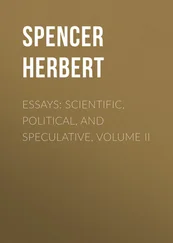Before comparing these conclusions with facts, let us pursue the reasoning a little further, and observe certain subordinate actions. The respective flocculi must be drawn not towards their common centre of gravity only, but also towards neighbouring flocculi. Hence the whole assemblage of flocculi will break up into groups: each group concentrating towards its local centre of gravity, and in so doing acquiring a vortical movement like that subsequently acquired by the whole nebula. According to circumstances, and chiefly according to the size of the original nebulous mass, this process of local aggregation will produce various results. If the whole nebula is but small, the local groups of flocculi may be drawn into the common centre of gravity before their constituent masses have coalesced with one another. In a larger nebula, these local aggregations may have concentrated into rotating spheroids of vapour, while yet they have made but little approach towards the general focus of the system. In a still larger nebula, where the local aggregations are both greater and more remote from the common centre of gravity, they may have condensed into masses of molten matter before the general distribution of them has greatly altered. In short, as the conditions in each case determine, the discrete masses produced may vary indefinitely in number, in size, in density, in motion, in distribution.
And now let us return to the visible characters of nebulæ, as observed through modern telescopes. Take first the description of those nebulæ which, by the hypothesis, must be in an early stage of evolution.
Among the " irregular nebulæ ," says Sir John Herschel, "may be comprehended all which, to a want of complete and in most instances even of partial resolvability by the power of the 20-feet reflector, unite such a deviation from the circular or elliptic form, or such a want of symmetry (with that form) as preclude their being placed in class 1, or that of Regular Nebulæ. This second class comprises many of the most remarkable and interesting objects in the heavens, as well as the most extensive in respect of the area they occupy ."
And, referring to this same order of objects, M. Arago says:—"The forms of very large diffuse nebulæ do not appear to admit of definition; they have no regular outline."
This coexistence of largeness, irregularity, and indefiniteness of outline, with irresolvability, is extremely significant. The fact that the largest nebulæ are either irresolvable or very difficult to resolve, might have been inferred a priori ; seeing that irresolvability, implying that the aggregation of precipitated matter has gone on to but a small extent, will be found in nebulæ of wide diffusion. Again, the irregularity of these large, irresolvable nebulæ, might also have been expected; seeing that their outlines, compared by Arago with "the fantastic figures which characterize clouds carried away and tossed about by violent and often contrary winds," are similarly characteristic of a mass not yet gathered together by the mutual attraction of its parts. And once more, the fact that these large, irregular, irresolvable nebulæ have indefinite outlines—outlines that fade off insensibly into surrounding darkness—is one of like meaning.
Speaking generally (and of course differences of distance negative anything beyond average statements), the spiral nebulæ are smaller than the irregular nebulæ, and more resolvable; at the same time that they are not so small as the regular nebulæ, and not so resolvable. This is as, according to the hypothesis, it should be. The degree of condensation causing spiral movement, is a degree of condensation also implying masses of flocculi that are larger, and therefore more visible, than those existing in an earlier stage. Moreover, the forms of these spiral nebulæ are quite in harmony with the explanation given. The curves of luminous matter which they exhibit, are not such as would be described by discrete masses starting from a state of rest, and moving through a resisting medium to a common centre of gravity; but they are such as would be described by masses having their movements modified by the rotation of the medium.
In the centre of a spiral nebula is seen a mass both more luminous and more resolvable than the rest. Assume that, in process of time, all the spiral streaks of luminous matter which converge to this centre are drawn into it, as they must be; assume further, that the flocculi, or other discrete portions constituting these luminous streaks, aggregate into larger masses at the same time that they approach the central group, and that the masses forming this central group also aggregate into larger masses; and there will finally result a cluster of such larger masses, which will be resolvable with comparative ease. And, as the coalescence and concentration go on, the constituent masses will gradually become fewer, larger, brighter, and more densely collected around the common centre of gravity. See now how completely this inference agrees with observation. "The circular form is that which most commonly characterises resolvable nebulæ," writes Arago. Resolvable nebulæ, says Sir John Herschel, "are almost universally round or oval." Moreover, the centre of each group habitually displays a closer clustering of the constituent masses than the outer parts; and it is shown that, under the law of gravitation, which we now know extends to the stars, this distribution is not one of equilibrium, but implies progressing concentration. While, just as we inferred that, according to circumstances, the extent to which aggregation has been carried must vary; so we find that, in fact, there are regular nebulæ of all degrees of resolvability, from those consisting of innumerable minute masses, to those in which their numbers are smaller and the sizes greater, and to those in which there are a few large bodies worthy to be called stars.
On the one hand, then, we see that the notion, of late years uncritically received, that the nebulæ are extremely remote galaxies of stars like those which make up our own Milky Way, is totally irreconcilable with the facts—involves us in sundry absurdities. On the other hand, we see that the hypothesis of nebular condensation harmonizes with the most recent results of stellar astronomy: nay more—that it supplies us with an explanation of various appearances which in its absence would be incomprehensible.
Descending now to the Solar System, let us consider first a class of phenomena in some sort transitional—those offered by comets. In them, or at least in those most numerous of them which lie far out of the plane of the Solar System, and are not to be counted among its members, we have, still existing, a kind of matter like that out of which, according to the Nebular Hypothesis, the Solar System was evolved. Hence, for the explanation of them, we must go back to the time when the substances forming the sun and planets were yet unconcentrated.
When diffused matter, precipitated from a rarer medium, is aggregating, there are certain to be here and there produced small flocculi, which long remain detached; as do, for instance, minute shreds of cloud in a summer sky. In a concentrating nebula these will, in the majority of cases, eventually coalesce with the larger flocculi near to them. But it is tolerably evident that some of those formed at the outermost parts of the nebula, will not coalesce with the larger internal masses, but will slowly follow without overtaking them. The relatively greater resistance of the medium necessitates this. As a single feather falling to the ground will be rapidly left behind by a pillow-full of feathers; so, in their progress to the common centre of gravity, will the outermost shreds of vapour be left behind by the great masses of vapour internally situated. But we are not dependent merely on reasoning for this belief. Observation shows us that the less concentrated external parts of nebulæ, are left behind by the more concentrated internal parts. Examined through high powers, all nebulæ, even when they have assumed regular forms, are seen to be surrounded by luminous streaks, of which the directions show that they are being drawn into the general mass. Still higher powers bring into view still smaller, fainter, and more widely-dispersed streaks. And it cannot be doubted that the minute fragments which no telescopic aid makes visible, are yet more numerous and widely dispersed. Thus far, then, inference and observation are at one.
Читать дальше












